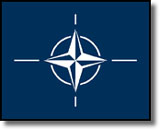
|
NATO HistoryNATO was developed originally to implement the North Atlantic Treaty signed in Washington on April 4, 1949, to establish a military counterweight to Soviet military might and to keep the peace in post-war Europe. The need for it was highlighted by the Berlin blockade, the Soviet-sponsored coup in Czechoslovakia, increased communist activity in Italy and France, and the threat of Norway falling under Soviet domination. The current membership consists of Belgium, Canada, Denmark, France, Germany, Greece, Iceland, Italy, Luxembourg, Holland, Norway, Portugal, Spain, Turkey, the UK, and its driving force, the United States. The geographical scope of the treaty covers Europe and North America, the North Atlantic to the north of the Tropic of Cancer, and the Mediterranean. The organisation's members have traditionally viewed it primarily as an alliance of mutual defence. Article V of the Treaty said: "The Parties agree that an armed attack against one or more of them in Europe shall be considered an attack against them all and consequently they agree that, if such an armed attack occurs, each of them ... will assist the party or parties so attacked ... to restore and maintain the security of the North Atlantic area."
The BBC does not endorse external links. |
Diana, Princess of Wales, 1961-1997
Conference 97
Devolution
The Archive
News |
Issues |
Background |
Parties |
Analysis |
TV/Radio/Web
Interactive |
Forum |
Live |
About This Site
News |
Issues |
Background |
Parties |
Analysis |
TV/Radio/Web
Interactive |
Forum |
Live |
About This Site
© BBC 1997 |
politics97@bbc.co.uk |
